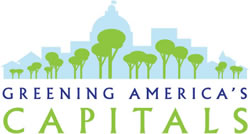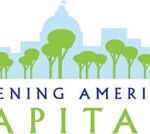Grand Avenue Becoming a Greener Avenue
Lower Grand Avenue is about to become a little greener now that Phoenix has been selected as one of five cities by the Partnership for Sustainable Communities to participate in the 2011 Greening America’s Capitals program. The Partnership for Sustainable Communities began in 2010 as an interagency partnership between EPA, the Department of Housing and Urban Development (HUD), and the Department of Transportation (DOT) to identify three to five capital cities per year seeking to redevelop vacant and underutilized inner-city land in an economically, environmentally sustainable way.
“America’s cities can be the engines of green innovation, leading the way in new technologies, energy efficiency and sustainable development,” said EPA Administrator Lisa P. Jackson. “EPA and our colleagues in the Partnership for Sustainable Communities are working with capital cities throughout the country to spark the sustainable, green innovations that can meet the needs of multiple communities, and keep our cities on the cutting edge of the global green economy.”
Breaking from the grid system of Phoenix, Grand Avenue cuts diagonally northwest away from the Downtown core between the Oakland and F.Q. Story historic neighborhoods, is adjacent to University and Woodland Parks, and is near the State Capitol. In short, Lower Grand Avenue is brimming with potential and possibilities. The Greening America’s Capitals project will help continue to build upon the revitalization efforts and sustainability success that Lower Grand Avenue has already achieved by improving the streetscape, exploring options to capture and treat storm water runoff as well as possible improvements to pedestrian crossings, transit shelters, and bike paths.
Growing up Grand
Partnerships between the city and federal agencies, non-profits, the faith-based community, artists, small business owners, and developers have revitalized Grand Avenue from a collection of derelict buildings into an eclectic, funky part of town that is home to the Grand Avenue Festival as well as a focus for Art Detour and First Fridays. What has been missing according to the city is “a holistic shared vision” of development and that’s how Greening America’s Capitals helps: the program works with state capitals to envision and implement strategies to create sustainable communities that benefit the neighborhood, the economy, and the environment.
Greening America’s Capitals is not a grant, rather it “provides direct technical assistance to communities by working with private-sector experts and leveraging other partners, such as HUD and DOT, to consider implementation options.”
To apply, the city had to select an area no larger than a neighborhood, but an area that could demonstrate to the rest of the city, region, and state how sustainable design benefits the quality of life for neighborhoods and residents. One of the stated goals of the project is to be a “testing ground for broader, citywide actions such as changes to local codes and ordinances to better support sustainable growth and green building.”
 Once Lower Grand Avenue had been identified as a prime location for this project, the Planning and Development Department of the city submitted a Letter of Interest to EPA identifying the challenges and potential impacts a greener design would have on the surrounding areas.
Once Lower Grand Avenue had been identified as a prime location for this project, the Planning and Development Department of the city submitted a Letter of Interest to EPA identifying the challenges and potential impacts a greener design would have on the surrounding areas.
The city cited the issue of parking that could be remedied by alternative transportation options, including a streetcar and bike lanes. The city also identified the need for mixed-use buildings, preserving and adapting historic warehouses, and the need for affordable housing options while retaining the unique sense of place that local business owners, residents and artists have created.
The capital cities of Alabama, Mississippi, Nebraska, and the District of Columbia were the other four cities chosen from 23 applicants. A team of regional urban designers, planners and landscape architects will be organized by EPA to provide the assistance to create and implement the vision of what green architecture and design can be in our unique, desert climate.
Supporters of the project are many and include the Arizona Department of Transportation, Grand Avenue Merchants Association, Grand Avenue Rail Project, FQ Story Preservation Association, Neighborhood Ministries, Capitol Mall Association and Local Initiatives Support Corporation.







